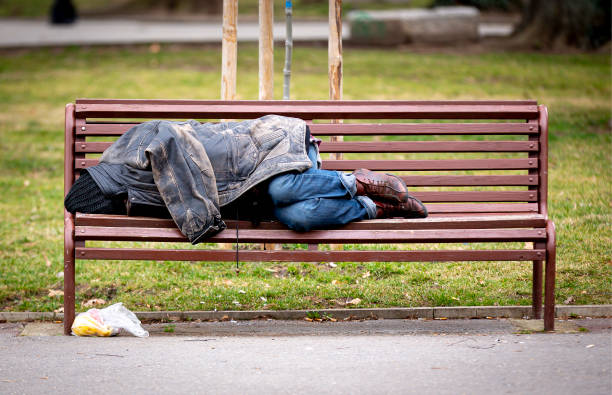
The Cycle of Housing Insecurity and Mental Illness in America
In the United States, the combined struggles of housing insecurity and severe mental illness create a cycle that is difficult to break. As rent prices soar and affordable housing becomes increasingly scarce, millions of Americans are trapped in a relentless struggle for stability. This crisis is worsened by a lack of access to mental health services and widespread stigma, leading to devastating consequences for those affected.
Housing Insecurity in America
Housing insecurity is the state of living in unstable or unfit conditions, such as facing the threat of eviction, residing in unsafe or overcrowded environments, or lacking a permanent home altogether. In January 2021, an estimated 15 million adults in the United States experienced housing insecurity.
The United States is currently facing a severe housing affordability crisis, meaning there is a shortage of affordable rental properties, rising median home prices, and an increasing number of families struggling to afford housing payments. Since 2019, rent prices have increased by a whopping 30%, and the gap between supply and demand has left at least 6.8 million low-income families without access to affordable housing. In fact, only 1 in 4 extremely low-income families receive the assistance they need.
Unsafe and Overcrowded
There is no state in the United States where a full-time minimum-wage worker can afford a two-bedroom apartment. Due to this limited rental market, low-income families often compromise comfort, cleanliness, and even safety when renting their homes. Overcrowding can occur when people are forced to move in with too many others to afford rent. This can mean at least two people sharing each bedroom or multiple families sharing a living space.
Eviction and Homelessness
When housing costs exceed what tenants can afford, foreclosure and eviction can occur. Research has shown that people forced to move this way are more likely to relocate to lower-income, higher-crime neighborhoods. Additionally, evictions and missed rent payments can grievously damage a person’s credit, making it much harder to find landlords willing to rent to them.
Homelessness represents the most severe form of housing insecurity. It involves not having a primary nighttime residence, relying on shelters, or residing in places not designed for sleeping. In January 2023, an estimated 653,000 people experienced homelessness in the United States on any given night, an increase of 12% from the previous year.
Mental Health Consequences of Housing Insecurity
In 1943, psychologist Abraham Maslow developed a hierarchy of needs humans require to reach their full potential. In this hierarchy, the very first needs that must be met are food, water, clothing, sleep, and shelter. Only when these needs are satisfied can people begin to fully address more complex requirements such as mental well-being, relationships, and esteem. Maslow’s hierarchy remains highly relevant today and can begin to explain why so many people with housing insecurity also struggle with their mental health.
Long-term housing affordability stress has been linked to depression, anxiety, psychological distress, and even suicide. In the two years following eviction, people were more likely to seek hospitalization for a mental health condition compared to those who were not evicted. Suicide rates linked to stress doubled between 2005 and 2010, a time of historically high increases in foreclosures and evictions.
For homeless individuals, rates of depression and suicidal thoughts are markedly higher compared to the general public. Of newly homeless individuals in New York City, 35% were found to have major depression. The short-term psychological effects of being homeless include depression, anxiety, post-traumatic stress disorder, panic attacks, and suicide.
The experience of living on the street can have devastating consequences for one’s mental health. A study across five U.S cities found that 98% of participants experiencing homelessness had been victims of a violent attack, with 73% experiencing an attack in the last year. A study of homeless women found that 18% had been sexually assaulted within the past six months. These instances of violence are yet another risk factor for mental health disorders such as PTSD, anxiety, and depression.
The Cycle of Housing Insecurity and Mental Illness
While homelessness can be a trigger for mental health disorders, in two-thirds of cases, mental illness precedes homelessness. Studies have consistently found that 25-30% of homeless individuals suffer from severe mental illness (SMI), such as schizophrenia and bipolar disorder.
With access to medication, comprehensive treatment plans, and strong support systems, people with serious mental illness can live fulfilling lives. However, with nationwide shortages of mental health specialists and psychiatric beds and the financial strain of long-term mental healthcare, many people with SMI do not have access to the essential healthcare they need.
When left untreated, people with SMI may become unstable, resulting in job loss, financial strain, and homelessness. Studies have identified poverty and lack of affordable housing as the primary causes of homelessness for those suffering from mental illness. Additionally, untreated individuals with SMI are more likely to isolate themselves from their friends, families, and support systems, leaving them vulnerable and without a safety net.
Homelessness Exacerbates Symptoms of SMI
While housing insecurity is often not the cause of severe mental illness, it can trigger and aggravate symptoms of existing mental illness. Being homeless creates a considerable barrier to accessing mental healthcare, leaving individuals untreated, socially isolated, and without a support system.
The psychological stress of living on the streets further intensifies anxiety, depression, paranoia, and PTSD. Substance use disorder is also common for people living on the street and is frequently used for survival. Aislinn Bird, a street psychiatrist working in San Francisco, reported that meth is often used to stay awake at night because it is unsafe to sleep when it is dark, while opioids are then used to fall asleep during the day. It is extremely difficult to break this habit of substance abuse while continuing to live in the same unsafe living condition that perpetuates the cycle. For individuals with SMI living without a home, opportunities to recover and thrive can be highly inaccessible.
Barriers to Breaking the Cycle
Breaking the cycle of housing insecurity and mental illness begins with realizing the systemic issues and societal attitudes that perpetuate it. Misconceptions about homelessness and mental illness, along with restricted access to healthcare and disconnected relief services, continue to prevent people from achieving stability in housing and mental health.
Stigma and Discrimination
The negative stigma surrounding housing insecurity and homelessness often prevents individuals from seeking or receiving the help they need. People experiencing homelessness are often seen as a blemish on society rather than as individuals struggling as a result of society’s systematic issues. Many assume that homelessness is avoidable and therefore deserved, so a blind eye is turned to their suffering.
Anti-homeless laws criminalize the unhoused, further perpetuating the idea that homelessness is a choice and reinforcing the negative stigma around it. When homelessness is framed as a crime, people are much less likely to reveal their situation and seek help from others. Many stigmas against homelessness also create barriers to job opportunities and employment, preventing a steady income and any chance of securing a home.
Negative stigma against people with severe mental illness can also make it harder to secure stable living environments. People struggling with their mental health may not speak up until they are in crisis for fear of being shamed for their condition. Delaying diagnosis and treatment can be highly detrimental to the relationships, employment, and finances of those experiencing SMI.
Lack of Access to Mental Health Service
For low-income families and people experiencing homelessness, paying for mental health services is much less of a priority than spending on basic needs like food, shelter, and clothing. Medicaid provides health coverage for lower-income individuals. However, there is an acute scarcity of psychiatrists who will accept Medicaid, rendering this service widely unattainable.
Nearly 40% of Americans live in areas with shortages of mental healthcare professionals. For people experiencing homelessness, encounters with psychiatrists are slim to none. Only 11% of U.S. psychiatry residency programs have mandatory rotations involving homelessness outreach, and studies show that this type of outreach only decreases as residents advance through their medical education.
There is a national shortage of inpatient hospital beds in America, leaving those in need of them to be turned away by emergency departments or discharged before they have fully stabilized. In many cases, this leaves those suffering from SMI with no safe place to go and at risk of deteriorating further into disruptive behavior, leading them to end up on the street or in jail.
Fragmented Services
The separation between housing services and mental health care can create gaps in support for people experiencing both mental health issues and housing insecurity. Because of this separation, people suffering from mental health issues may be given housing without the necessary mental health support or mental health support while continuing to struggle with their living situation.
Maintaining stability becomes nearly impossible when one need remains unmet, leading to recurrent crises and setbacks. This fragmentation is particularly detrimental to those with SMI, who require consistent and integrated care to manage their conditions effectively.
Strategies for Intervention
Integrated Care Models
Combining housing and mental health services into one program, such as supportive housing, helps to address both major needs so that individuals can receive full comprehensive support. Instead of simply placing someone in a house and walking away, service providers can help newly housed individuals understand a lease, pay rent on time, manage medications, and work towards employment. Historically, supportive housing has helped to decrease the amount of people experiencing chronic homelessness.
Housing First Approach
In the past, receiving housing was contingent on proving “housing worthiness” by getting clean, adhering to treatment plans, and demonstrating some level of recovery. According to this system, housing is not a human right, but something deserved or undeserved. This model did not consider the challenges of recovering while struggling with housing insecurity.
The housing first approach reverses the usual care continuum by providing stable housing first so that individuals have a safe and supportive home in which to recover. This is an evidence-based program that has seen significant reductions in homelessness, with 75-91% of households remaining housed after the first year. This program also provides supportive services such as mental health care to ensure housing stability.
Ending the Cycle
The cycle of housing insecurity and mental illness in America presents a complex and urgent challenge. This cycle is deeply entrenched in systemic failures and societal misconceptions. Housing insecurity not only exacerbates mental health issues but also makes it nearly impossible for individuals to access the help they need. From the escalating costs of housing to the fragmented services and stigma surrounding mental health, every part of this issue reinforces and perpetuates the cycle.
Addressing this crisis requires a comprehensive approach that simultaneously tackles housing and mental health needs. Mental health cannot be fully addressed until basic needs are fulfilled, while housing becomes challenging to retain with deteriorating mental health. Support is needed at every step of the journey to ensure that stability is maintained and opportunities to thrive are no longer out of reach.
